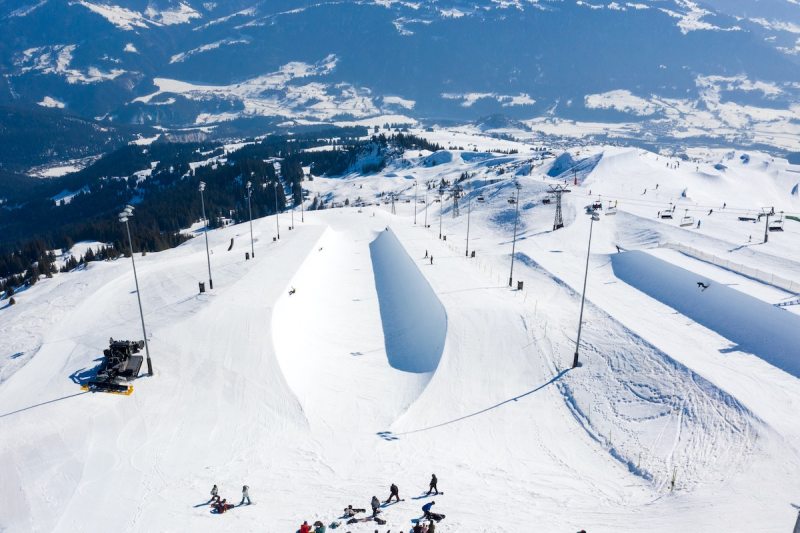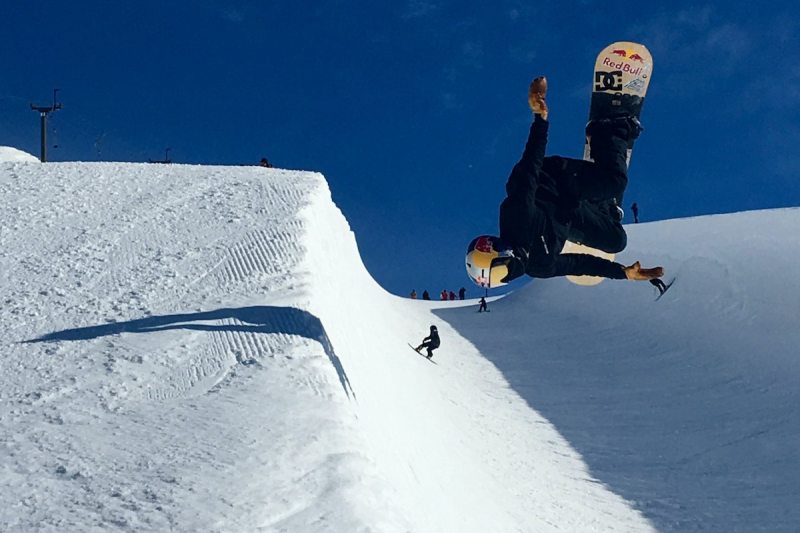Snowboarding events are some of the most exciting competitions to watch. In some Olympic snowboarding events, athletes get big air and execute the unthinkable when it comes to tricks and jumps, while in other snowboarding events, athletes race head to head and demonstrate incredible speed, technique, and precision.
However, for viewers at home, it can be confusing to follow all of the different snowboarding events at the Olympics, particularly because the sport is still in somewhat of its nascent stage and it seems like there are snowboarding events at the Olympics every other time the highly anticipated Games grace our television screens. But don’t worry — we have you covered; below, enjoy our event guide for snowboarding events at the Winter Olympics and get ready to cheer on the top athletes as they take on the Half Pipe, Big Air, Parallel Slalom, and more.
Is There Snowboarding At the Olympics?

Snowboarding is one of the fastest-growing sports at the Winter Olympics. At. the 2022 Beijing Olympic Winter Games, there will be 11 snowboarding events, all of which will be contested from Feb. 5-12.
Snowboarding made its Olympic debut at the 1998 Winter Olympics with two events—halfpipe and giant slalom. At the 2006 Winter Olympics in Torino, a snowboard cross was added. The Slopestyle event debuted at the 2014 games in Sochi, and Big Air was introduced in 2018 at the Olympics in Pyeongchang. At the upcoming 2022 Olympics in Beijing, a mixed team snowboard cross will be contested.
What Types of Snowboarding Are At the Olympics?

There are two different types of snowboarding at the Olympics: Freestyle and racing. Freestyle snowboarding includes Halfpipe, Slopestyle, and Big Air, and features tricks and jumps. Snowboard racing is all about speed and includes events like Parallel Giant Slalom and Snowcross.
Medals will be awarded in 11 snowboarding events at the Olympics in Beijing.
- Women’s Slopestyle (Feb. 5-6)
- Men’s Slopestyle (Feb. 6-7)
- Women’s Parallel Giant Slalom (Feb. 8)
- Men’s Parallel Giant Slalom (Feb. 8)
- Women’s Snowboard Cross (Feb. 9)
- Women’s Halfpipe (Feb. 9-10)
- Men’s Snowboard Cross (Feb. 10)
- Men’s Halfpipe (Feb. 9, 11)
- Mixed Team Snowboard Cross (Feb. 12)
- Women’s Big Air (Feb. 14-15)
- Men’s Big Air (Feb. 14-15)
What Are the 5 Different Events of Snowboarding at the Winter Olympics?
Parallel Giant Slalom
Parallel Giant Slalom is the event that has replaced Giant Slalom. This snowboarding event involves two riders racing down parallel courses side-by-side at the same time, making turns around gates. Racers go up to 43 kph and must hit the turns correctly while barreling down the course as quickly as possible.
Although the athletes appear to be head-to-head, in the qualification round, they are actually just racing the clock, not one another. Riders can be disqualified in the Parallel Giant Slalom if they false start, pass through the incorrect gate, do not turn on the outside of a gate, disturb their opponent, or finish without at least one foot strapped to the snowboard.
There is a qualification round followed by a head-to-head elimination round for this snowboarding event at Olympics. In the qualification round, each competitor takes two runs; one down the red course and one down the blue course. The finish times for the two runs are summed, and the snowboarders with the 16 fastest total times advance.
In the head-to-head elimination round, the 16 qualifiers are seeded based on their times and compete head-to-head in a bracket-style. During the elimination, the faster seed gets to choose which side of the course they race (red or blue), and the athletes only have one run. The competitor who finishes their side of the course faster wins. The bracket plays out until the champion is determined. The silver medalist is the loser in the final and the bronze medalist is the winner of the “small final.”
Halfpipe

Halfpipe, also called superpipe, is a snowboarding event where athletes traverse through the halfpipe — a U-shaped track with 22-foot walls — while performing tricks off the walls. It has been an Olympic event since 1998. If the athlete stops for more than 10 seconds, their run is terminated and their score only includes points accrued up to the termination. A panel of judges scores each rider based on the difficulty, variety, and execution of the tricks they attempt, their use of the halfpipe, the height they achieve, and their ability to link tricks in a progressive way.
There is a qualification round and a final round in this snowboarding event at the Olympics. The qualification round of the halfpipe may have up to 25 individual riders for both the men’s and women’s halfpipe. Each rider completes two runs, with their top score serving as their final score. The top 12 athletes then progress to the final round where they start with a clean slate in terms of scores.
In the final round, each rider completes three runs, with their best score serving as their final score. Athletes compete in the inverse order of their finishing order from the qualification round. The rider with the highest score from the final round wins.
Snowboard Cross
Also called boardercross, snowboard cross features a course with obstacles like jumps, rollers, and banked turns, as it is heavily influenced by motocross tracks. In this Olympic snowboarding event, up to six snowboarders race on the downhill course simultaneously, with the top three finishers moving on to the next round. Because numerous athletes are racing simultaneously, there are judges and a race jury to determine any disqualifications, such as if competitors deliberately interfere with other competitors. All contact is reviewed for its fairness.
The snowboard cross events at the Olympics consist of seeding rounds and elimination rounds. In the seeding rounds, each of the 32 competitors takes timed individual runs through the course to seed the riders and split them into heats such that top riders are spread throughout so they won’t meet until later in the bracket. Competitors are then given colored bibs according to their ranking in their heat (red, green, blue, yellow, white, and black, from first to sixth seed), and get to choose the gate they start from in the order of their seed ranking. Riders progress through the bracket based on placement in their heat.
For the first time this year in Beijing, there’s a Mixed Team Snowboard Cross event, which has a similar format, but there are two athletes (one male and one female) per team.
Slopestyle
Like halfpipe, Slopestyle is another snowboarding event that features tricks and jumps. However, the course is more varied, and usually has six features (three rails and three jumps) that snowboarders hit on their run and use to perform tricks. Athletes are judged on the difficulty of the tricks they attempt, the height they achieve, and the overall execution of the jumps. A panel of nine judges scores the Slopestyle event. Each score can be up to 100 points, with 60% consisting of their trick score and 40% being the overall impression.
This Olympic snowboarding event consists of a qualification round and a final round. Each rider takes two runs in the qualification round, with the best score counting. The top 12 athletes advance to the final, where they each complete three runs.
Big Air
Big Air can almost be equated to a vault in gymnastics. This snowboarding event involves a run that includes one single jump on the course. Riders have one chance to execute their most impressive tricks as they hit the jump. Competitors who make it to the finals get to do three rounds but must land two different tricks on different rounds.
There are two portions of the Big Air snowboarding event at the Olympics; a qualification round and a final round. In the qualification round, each rider takes three runs and their top score is counted. Competitors earning the top 12 scores advance to the final, and scores are reset. The riders then complete three runs. They compete in the reverse order of their finish ranking from the qualification round. For each athlete, the scores from their two best runs of the three are summed for their final score. However, it’s important to note that rides must spin their tricks in different directions on the two scoring runs. For example, if an athlete spins a backside rotation on one of the two runs, they must spin a front-side rotation on the other. Moreover, when the same rotation is performed multiple times, only the top score is counted for that trick.



